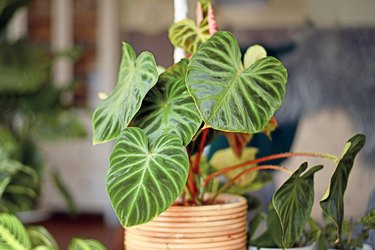
Philodendron plants (Philodendron spp.) are commonly seen as houseplants because they can grow with little maintenance and low levels of light. While indoor philodendron plants rarely experience serious problems, brown tips on leaves can occur. When this happens, overfertilization is usually the cause. Changing your approach to fertilizing may solve this problem.
Characteristics of Philodendron Plants
Video of the Day
Philodendrons are tropical plants native to the Americas that adapt well to indoor environments, and are therefore often used in residential and commercial interior spaces. Some philodendron species grow as climbing vines, while others have a more upright, tree-like form. Both can be grown indoors.
Video of the Day
One of the most popular philodendron species is the heartleaf philodendron (Philodendron hederaceum), which, as its name suggests, has heart-shaped leaves. The leaves of the species heartleaf philodendron are dark green; however, the 'Aureum' cultivar offers chartreuse-colored foliage, while the leaves of 'Brazil' have a yellow stripe in the middle of the leaf. This species is great for hanging baskets.
The tree philodendron (Philodendron bipinnatifidum) can be up to 15 feet tall, which makes it better for commercial spaces like shopping centers and office buildings. The more compact 'Xanadu' cultivar is an option for home environments, however, as it has maximum heights between 2 and 3 feet.
Brown Tips on Philodendron Plants
Philodendron plants are considered heavy feeders, meaning they benefit from consistent feeding with fertilizer when they are actively growing. A general houseplant fertilizer is appropriate for philodendron plants. Fertilizers rich in nitrogen will produce larger leaves. Philodendron plants growing in low light generally need less fertilizer, however.
If you notice the tips of philodendron leaves turning brown, it is likely that the plant has been overfertilized. Excessive fertilizer can also harm the plant's roots. If this happens, reduce fertilizer applications. You can also attempt to leach the soil by applying excess water and allowing it to drain out completely. However, if you applied a slow-release fertilizer, it may be necessary to repot the plant in order to save it.
Caring for Philodendron Plants
Philodendron plants will grow easily from cuttings and can also be propagated via air layering. These plants will grow in many types of soils and soilless potting mixes. The potting medium should be kept moist, but it is just as important to provide good drainage to avoid standing water that can damage the plant's roots. Note that poorly-drained soil and overwatering can result in the plant's lower leaves turning yellow, a condition known as chlorosis.
Keep your philodendron plant where it receives indirect sunlight. While many plants benefit from direct sunlight, philodendron plants that receive too much sun will end up with yellowish leaves. Artificial light is acceptable in the absence of natural light. These plants can also handle dry indoor air, but will benefit from a light misting of water from time to time.
Philodendron plants prefer a warm environment, so locate them in a room with temperatures at 65 degrees Fahrenheit or above. If you are keeping any philodendron plants outdoors on a deck or porch in a cold climate, be sure to bring them inside before temperatures drop in the fall.